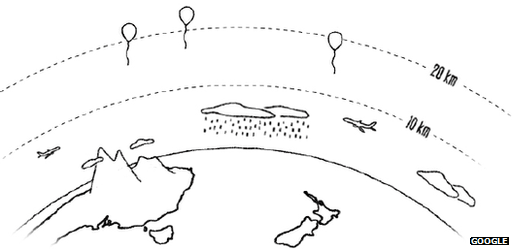
Google is launching balloons into near space to provide internet access to buildings below on the ground.
About 30 of the superpressure balloons are being launched from New Zealand from where they will drift around the world on a controlled path.
Attached equipment will offer 3G-like speeds to 50 testers in the country.
Access will be intermittent, but in time the firm hopes to build a big enough fleet to offer reliable links to people living in remote areas.
It says that balloons could one day be diverted to disaster-hit areas to aid rescue efforts in situations where ground communication equipment has been damaged.
But one expert warns that trying to simultaneously navigate thousands of the high-altitude balloons around the globe’s wind patterns will prove a difficult task to get right.
Airborne for months
Google calls the effort Project Loon and acknowledges it is “highly experimental” at this stage.
Each balloon is 15m (49.2ft) in diameter – the length of a small plane – and filled with lifting gases. Electronic equipment hangs underneath including radio antennas, a flight computer, an altitude control system and solar panels to power the gear.
Google aims to fly the balloons in the stratosphere, 20km (12 miles) or more above the ground, which is about double the altitude used by commercial aircraft and above controlled airspace.
Google says each should stay aloft for about 100 days and provide connectivity to an area stretching 40km in diameter below as they travel in a west-to-east direction.
The firm says the concept could offer a way to connect the two-thirds of the world’s population which does not have affordable net connections.
“It’s pretty hard to get the internet to lots of parts of the world,” Richard DeVaul, chief technical architect at Google[x] – the division behind the scheme – told the BBC.
“Just because in principle you could take a satellite phone to sub-Saharan Africa and get a connection there, it doesn’t mean the people have a cost-effective way of getting online.
“The idea behind Loon was that it might be easier to tie the world together by using what it has in common – the skies – than the process of laying fibre and trying to put up cellphone infrastructure.”
‘Low risk’
Previous proposals to provide connectivity from the upper atmosphere suggested floating high-altitude platforms that stayed in one place and were tethered to the ground.
Google rejected this idea as it involved fighting the winds, meaning the equipment would have to be large, expensive and limited to a fixed area.
The Latest Bing News on:
Internet access
- Broadband service problems for Wellingborough residents as town left without internet access for up to two dayson May 9, 2024 at 9:29 am
Residents local to Wellingborough have been experiencing internet service issues, with some experiencing spotty service over the past two days. People have reported issues all over Wellingborough such ...
- Joint Foreign Chambers call for immediate passage of bill to expand internet accesson May 9, 2024 at 9:06 am
The Joint Foreign Chambers of the Philippines (JFC) has called for the immediate passage of the Konektadong Pinoy Bill, formerly known as the Open Access in Data Transmission Act, to bridge “critical” ...
- UpLink Raises $10M to Decentralize Internet Access for the Masseson May 9, 2024 at 6:31 am
The founders and team started working on Uplink to upgrade connectivity. First it was through Mesh networks, then SDKs, and then this ultimately led the team towards building decentralized ...
- NTXIA and NCTCOG Partner to Re-Launch "Internet for All" Coalition as Internet for North Texas to Expand Internet Access Across North Texas Regionon May 9, 2024 at 6:00 am
In partnership with the North Central Texas Council of Governments (NCTCOG), this coalition represents a collaborative effort across North Texas to prioritize broadband infrastruct ...
- 236,000 in WNY will lose internet access, or see increased bills, if a federal program expires at month's endon May 8, 2024 at 4:58 pm
The Affordable Connectivity Program benefits more than 236,000 WNY households. Funding expires at the end of May, and Congress can't agree on a new funding bill.
- Patent Trolls Threaten Floridian Seniors’ Access to the Interneton May 8, 2024 at 5:04 am
By Saul Anuzis Like Americans across the country, Florida’s senior citizens rely on their smartphones and laptops to access the critical broadband infrastruc ...
- A Tech Too Far? School district’s internet policies spark debate among students about restricting accesson May 7, 2024 at 4:00 am
Whether it’s protecting students from dangerous websites, preventing access to sites students want, or impacting Wi-Fi connectivity, the school district’s internet policies play a significant role ...
- Millions of Americans could lose home internet access next monthon May 7, 2024 at 2:45 am
The Affordable Connectivity Program has subsidized internet costs for 23 million households, allowing some customers to purchase home internet for the first time. Without action by Congress, the ...
- Affordable Connectivity Program Expiring: What This Means For Millions Of Americans’ Internet Accesson May 5, 2024 at 11:35 am
A $7 billion plan to extend the internet subsidy program through the end of the year has been proposed in the House and the Senate.
- Reliable, affordable internet access still a challenge for many Nigerians – NIGCOMSATon May 5, 2024 at 6:07 am
The Managing Director and Chief Executive Officer of the Nigeria Communications Satellite, NIGCOMSAT, Engr. James Egerton-Idehen has disclosed that reliable and affordable internet access remains a ...
The Latest Google Headlines on:
Internet access
[google_news title=”” keyword=”internet access” num_posts=”10″ blurb_length=”0″ show_thumb=”left”]
The Latest Bing News on:
Internet access in remote areas
- 'It was like the internet back then': Restored Door County Bookmobile back after 33 yearson May 8, 2024 at 12:03 am
EGG HARBOR - With all the recent efforts to improve high-speed internet access to the more remote areas of Door County, it might be hard for some people to imagine that similar efforts were made just ...
- Best satellite internet: Guide for 2024on May 7, 2024 at 8:19 am
Do you live on the road or in a rural area and still want access to high-speed internet? Discover the best satellite internet services for 2024.
- The collapse of affordable internet will hit indigenous communities the hardeston May 1, 2024 at 4:00 am
Tucked beside the St. Lawrence River in northern New York and straddling the US-Canadian border, the Akwesasne Mohawk Nation has nurtured generations of indigenous artisans.
- Over 900,000 NC households to lose affordable internet if federal funding is not renewedon April 26, 2024 at 1:25 pm
The Affordable Connectivity Program, which launched Dec. 31, 2021, provides eligible low-income households with a discount on internet service.
- The Best Internet Providers for Rural Areason March 27, 2024 at 12:01 pm
Rural communities now have access to various internet options ... making it more practical to deploy in remote areas. Additionally, Starlink’s low-latency and high-bandwidth capabilities ...
- Internet spots eyed in remote areason December 21, 2023 at 8:25 am
Right now, it's around 12,000," Paraiso said. The DICT had said setting up these internet access points in remote areas would "greatly aid" the department in linking up with other government ...
- High-Speed Internet for Rural Areas Gets Over $600 Million From USDAon August 22, 2023 at 8:59 pm
People living in remote parts of the US may soon find it a little easier to get access to broadband ... residents and businesses with high-speed internet, the US Department of Agriculture said ...
- Malaysia issues licence to Elon Musk’s Starlink to bring Internet services to remote areason July 20, 2023 at 10:40 am
KUALA LUMPUR: Malaysia has issued a licence to Starlink, the satellite communications service started by Elon Musk, to provide Internet services in the country, particularly in remote areas ...
- Alphabet bets on lasers to deliver internet in remote areason June 26, 2023 at 11:12 am
MOUNTAIN VIEW, California (Reuters) - Google parent Alphabet has already tried and failed to bring internet access to rural and remote areas by using high-altitude balloons in the stratosphere.
- What Is Satellite Internet?on September 10, 2020 at 2:55 pm
For example, consumers living in off-grid cabins, cottages, or remote vacation homes ... learning opportunities in rural areas, as well as providing internet access to aircraft in the maritime ...
The Latest Google Headlines on:
Internet access in remote areas
[google_news title=”” keyword=”internet access in remote areas” num_posts=”10″ blurb_length=”0″ show_thumb=”left”]











